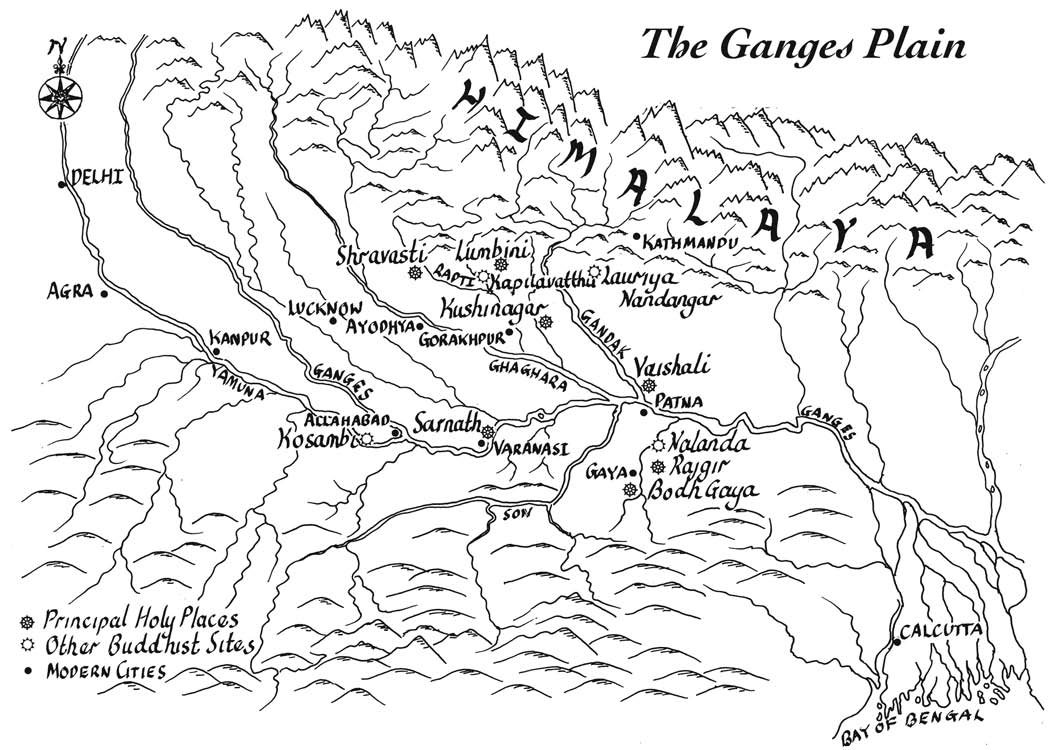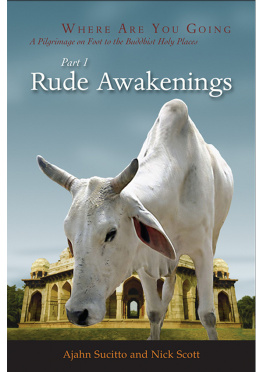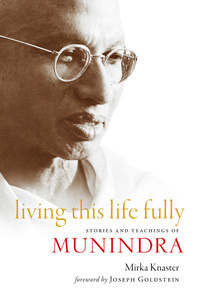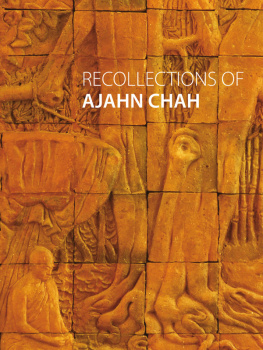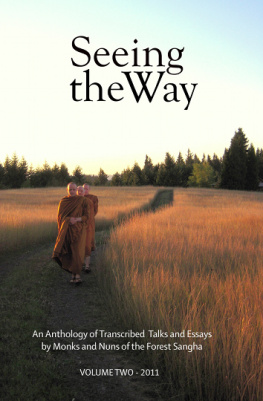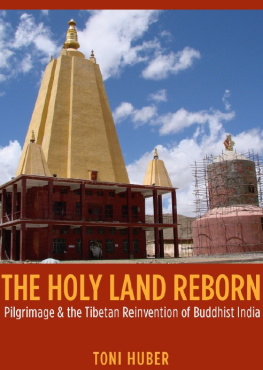Copyright
Rude Awakenings
Amaravati Publications
Amaravati Buddhist Monastery
Great Gaddesden, Hertfordshire, HP1 3BZ
United Kingdom,
www.amaravati.org
Amaravati Publications is a part of The English Sangha Trust Ltd, UK registered charity no. 231310
First published by Wisdom Publications 2006
This electronic edition published 2012
Digital Edition 1.0
ePub ISBN 978-1-870205-54-2
Copyright 2010 Ajahn Sucitto and Nick Scott,
Chithurst Monastery
This book is offered as a gift of Dhamma. It has been made available through the faith, effort and generosity of people who wish to share the understanding it contains with whomever is interested. This act of freely offering is itself part of what makes this a Dhamma publication, a book based on spiritual values. Please do not sell this book in any form, nor otherwise use it for commercial purposes.
If you wish to help publications such as this one continue to be made available, you can make a contribution, however small or large, by either contacting one of our monasteries (for a listing see www.forestsangha.org) or by visiting www.amaravati.org or www.forestsanghapublications.org

This work is licenced under the Creative Commons Attribution-NonCommercial-NoDerivs 2.0 UK: England & Wales Licence. To view a copy of this licence, visit: http://creativecommons.org/licenses/by-nc-nd/2.0/uk/
Summary:
You are free:
- to copy, distribute, display and perform the work
Under the following conditions:
- Attribution: You must give the original author credit.
- Non-Commercial: You may not use this work for commercial purposes.
- No Derivative Works: You may not alter, transform, or build upon this work.
With the understanding that:
- Waiver: Any of the above conditions can be waived if you get permission from the copyright holder.
- Public Domain: Where the work or any of its elements is in the public domain under applicable law, that status is in no way affected by the license.
- Other Rights: In no way are any of the following rights affected by the license:
- Your fair dealing or fair use rights, or other applicable copyright exceptions and limitations;
- The author's moral rights;
- Rights other persons may have either in the work itself or in how the work is used, such as publicity or privacy rights.
- Notice: For any reuse or distribution, you must make clear to others the licence terms of this work.
Bhikkhu Sucitto and Nick Scott assert their moral right to be identified as authors of this book, and request that you refer to Amaravati Publications for permission to copy, distribute, display or perform this work.
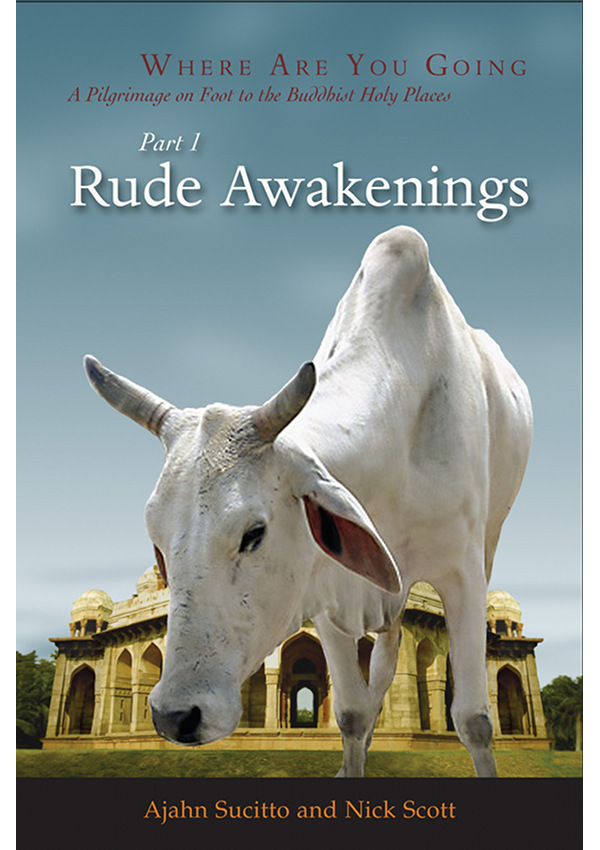
The mindful exert themselves;
they are not attached to any home.
Like swans that abandon the lake,
they leave home after home behind.
Dhammapada
Dedicated to our teacher,
Luang Por Sumedho,
and to our parents:
Charlie, Win, Bert, and Dot.
Where Are You Going
A Pilgrimage on Foot to the Buddhist Holy Places
Part 1:
Rude Awakenings
Ajahn Sucitto and Nick Scott
Amaravati Publications
Further resources
This book and many others from Venerable Ajahn Chah, Ajahn Sumedho, and their disciples are freely offered and available in various electronic formats as well as in print. You can find them via our monasteries and through the websites listed below, along with other resources such as audio talks, meditation instruction and retreats. Everything is free of charge, and everyone is welcome.
For books and audio:
www.forestsanghapublications.org
www.amaravati.org
For a list of Ajahn Chah community monasteries worldwide:
www.forestsangha.org
For further Theravada Buddhist literature including English translations of much of the Pali Canon:
www.accesstoinsight.org
Note to the reader
In order to make this e-book readable in a variety of electronic formats a simplified form of representing Pali words has been used; some of the diacritical marks have therefore not been included in this edition.
To check the spelling of any particular Pali word, please consult the Pali Text Society's Pali-English Dictionary, the Buddhist Publication Societys Buddhist Dictionary: Manual of Buddhist Terms and Doctrines, or other resources available on the Internet.

Ajahn Sucitto and Nick at Harnham Buddhist Monastery in England just prior to their departure. It was this photograph that the authors handed out during the pilgrimage.
Preface
What follows is the narrative of a pilgrimage around the Buddhist holy places of India and Nepal made in the winter 199091. We made the pilgrimage on foot over six months, but recording it has taken more than ten years. While our journey took us to all the main pilgrimage sites, it was also a pilgrimage through the sacred and profane of two very different mens lives and the lessons learned from making this pilgrimage together.
We wrote this account to honour the peoplemany of them humble Indian and Nepali villagerswho supported us in the pilgrimage. We also wished to communicate some of the grittier realities of practising the Buddhist spiritual life on the roadwith the understanding that this is where, in the time of the Buddha, it all began. Thus this pilgrimage is also a down-to-earth analogy for spiritual practise as we understand it. The living thing is both tougher and more wonderful.
Early in the writing we realised that both our voices needed to be heard. Alternating authors fit better the Buddhist understanding that realities depend on perspective. It also freed us to be really honest with our thoughts about each other. The completed account we called Where Are You Going? something we were asked over and again as we walked through India. We present here the account of the first three months, and although this is just half our journey, it retains all the difficulties and comedy of the pilgrimage plus a climax and a resolution.
Sources and references for works quoted in this book are contained in the chapter notes at the back. The narratives Indian locale and Buddhist context required the use of some foreign and technical terms, and to make this easier for the reader, we have appended a glossary. Quotes attributed to the Buddha are set in italics. Modern place names follow the use by the Survey of India, and Buddhist terms use the Pali-language version from the Theravadan texts unless the Sanskrit version is well known.
We hope you enjoy this book, but more than that we hope that by reading it you may share in the insights our journey gave us into ourselves.
Ajahn Sucitto
Nick Scott
Chithurst Monastery April 2005
The First Moon:
The Middle Land

Map of the Ganges Plain
